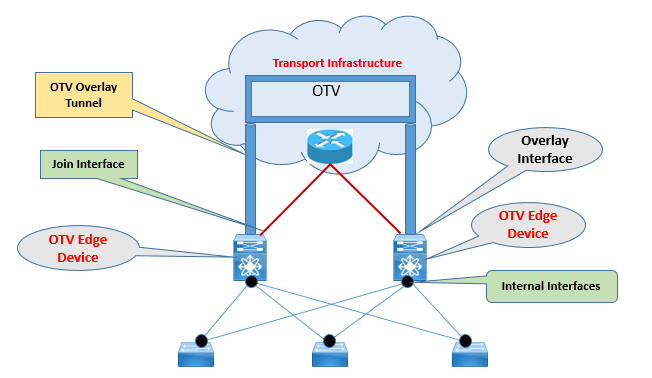EMAIL SUPPORT
dclessons@dclessons.comLOCATION
USOTV Terminology & Concepts
Overlay Transport Virtualization is IP based method to provide Layer 2 extension between different sites over any transport Infrastructure like Layer2 Transport, Layer 3 transport, MPLS, Internet etc.
OTV provides MAC routing which can exchange the MAC reachability information between devices which are on different sites,are reachable via any method of IP connectivity.
As we say that OTV provides MAC reachability over IP network then every Ethernet frame which has to be sent across different sites are encapsulated in to IP packet and is delivered across the network. While using existing IP transport network it reduces the use of establishing Virtual Circuit (Like L2 circuit, VPLS, L2VPN, Black fiber) which are costly.
Following are the benefits of using OTV.
- No need for (EoMPLS) or Virtual Private LAN Services (VPLS) deployment for Layer 2 extensions
- OTV uses any network transport that supports IP reachability between sites.
- Spanning Tree Protocol (STP) isolation is achieved by using OTV.
- Bridge Data Protocol Unit (BPDU) filtering is by default done using OTV
- Unknown unicast is not sent to the overlay, this helps in proper BW utilization.
- Address Resolution Protocol (ARP) optimization with the OTV ARP cache
- OTV provides First Hop Redundancy Protocol (FHRP) isolation
- Any number of sites can be added on same OTV Overlay Network.
OTV Terminology:
To understand properly about how OTV works on existing IP transport environment, let’s understand the OTV terminology.
By using below figure we will figure out OTV different terms.

Edge Device:
OTV edge device is the NXOS device which perform OTV functions like:
- Receives the layer 2 packet which needs to be extended to remote location and encapsulate to OTV Frame then then in to IP frame.
- There must be at least two edge device on each site to provide redundancy and resiliency.
Internal Interface:
- Internal Interface are those interface which receives the layer 2 traffic from DC access layer switch.
- Internal Interface can be access port or trunk port connecting different access layer switch or any ESXi host.
- All Layer 2 Function like STP, Switching, MAC learning are done on Internal Interface.





LEAVE A COMMENT
Please login here to comment.